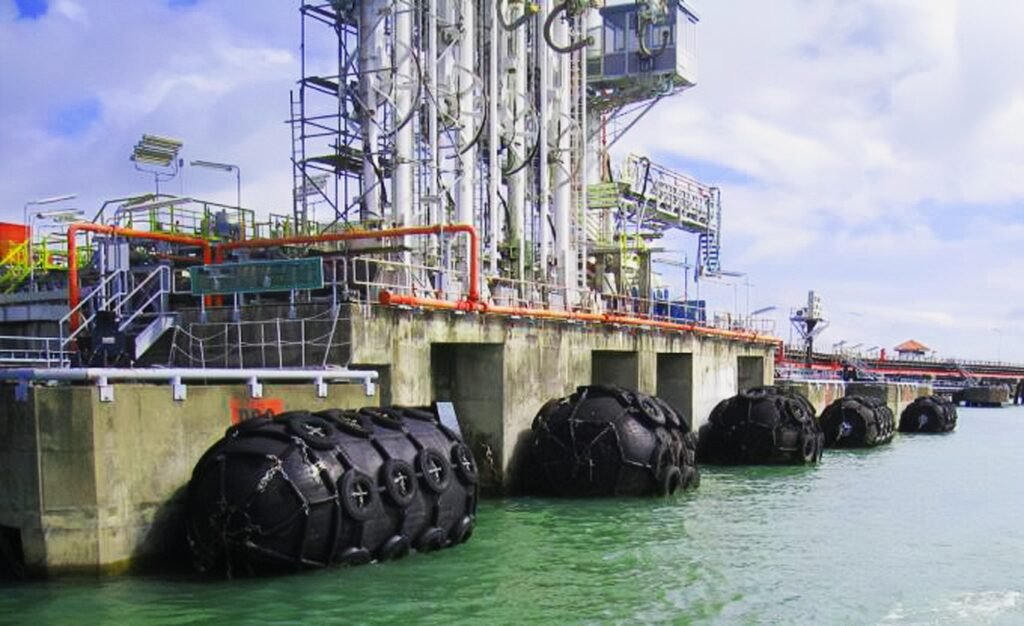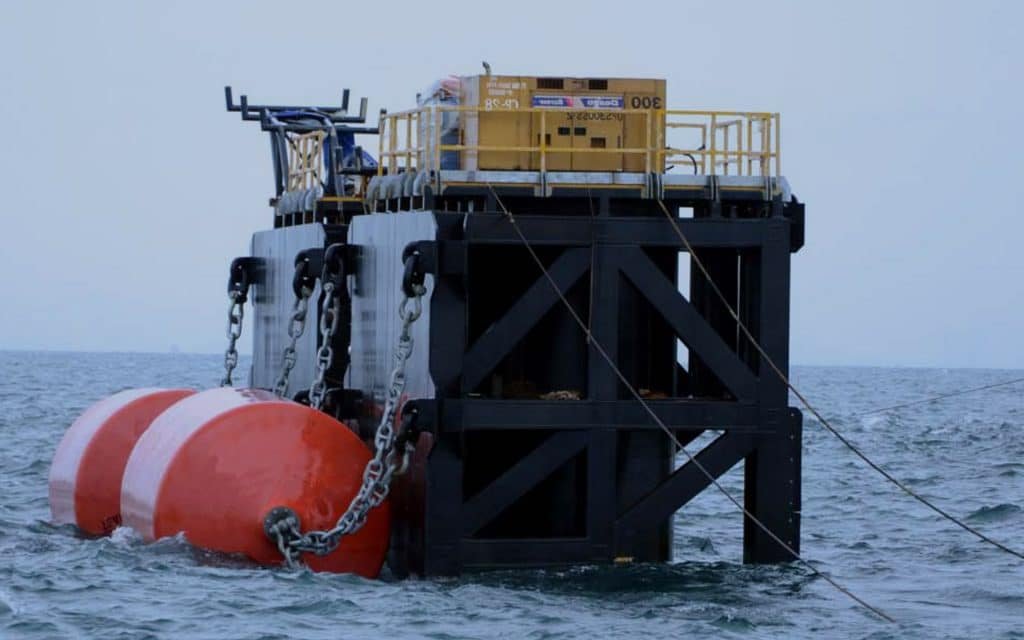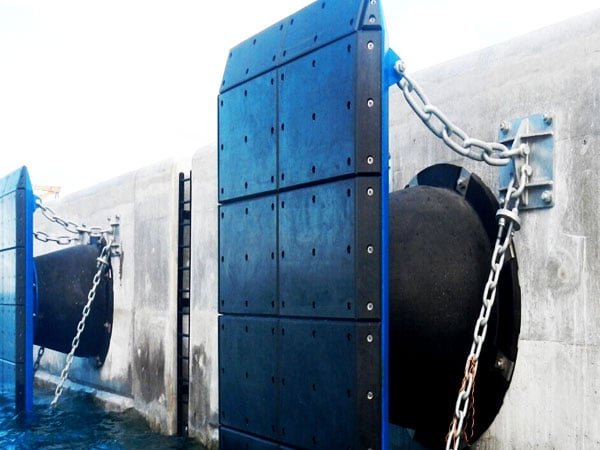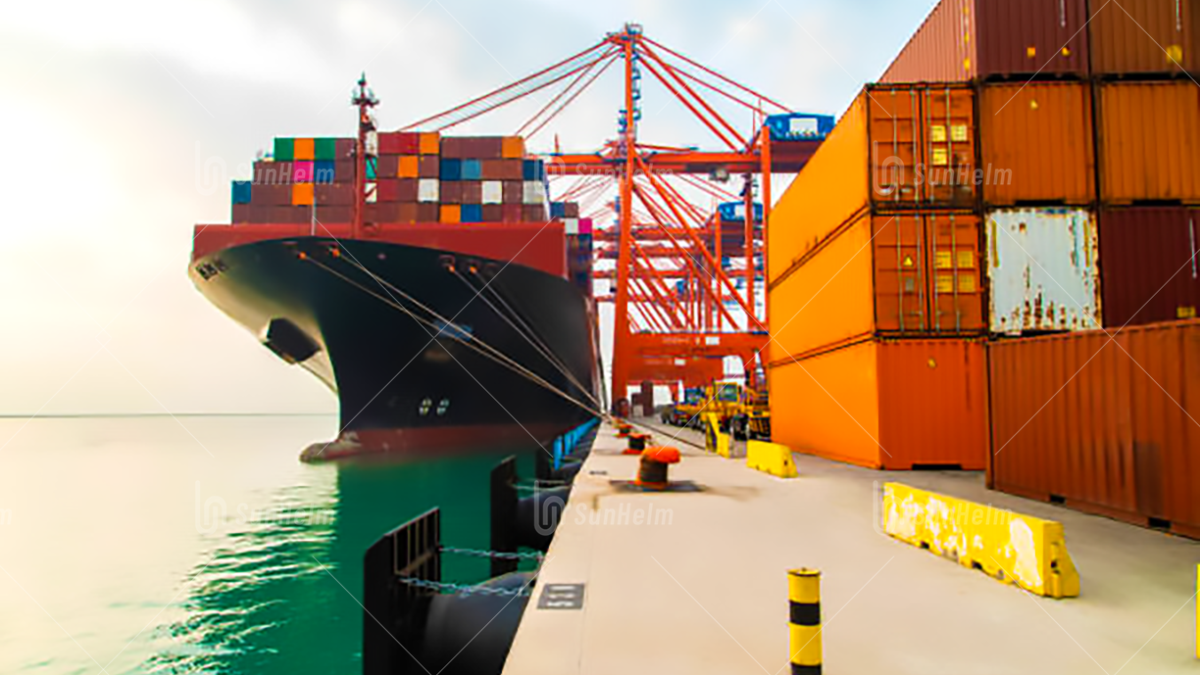Marine fenders are like “shock absorbers” between ships, docks, and offshore structures. Their main job is simple: to absorb collision energy, reduce impact forces, and protect ships and port structures from damage.
They are widely used in many situations, such as port berthing for cargo ships and passenger ships, ship-to-ship transfers, offshore platform supply operations, ship launching, ship repair, and even in special offshore rescue or towing tasks. In short, whenever two hard surfaces — like ships, docks, or platforms — need to touch but you want to avoid serious structural damage, marine fenders are essential.
Common Types of Marine Fenders
- Pneumatic fenders (inflatable rubber fenders)
These look like big rubber balloons filled with air.
Advantages: High energy absorption, soft surface contact, and the ability to adapt to different drafts and angles. They are commonly used for ship-to-ship transfers and offshore operations.
Disadvantages: Require regular pressure checks and protection against punctures.
Tip: Pneumatic fenders should meet the ISO 17357 international standard. Manufacturers like SUNHELMMARINE have improved production techniques and materials, making their pneumatic fenders exceed ISO 17357 requirements. - Cell Rubber fenders
Made of solid rubber with a more rigid structure, these fenders are durable and provide stable reaction forces. They are widely used for fixed berths and heavy ship berthing at ports. - Foam-filled fenders
Filled with closed-cell foam instead of air, these fenders require no inflation and are almost maintenance-free. They are resistant to punctures and will still float and work even if the surface is damaged. They are ideal for low-maintenance docks or remote terminals. - Cone rubber fenders
An improved version of cell fenders, cone-shaped fenders can handle larger berthing angles and are often used at busy ports with large vessels.




How Marine Fenders Work?
Marine fenders work by absorbing the energy generated during a collision and reducing the force passed on to the ship or dock.
When a ship touches a fender, the fender’s material — whether rubber, foam, or pneumatic — compresses or bends. This deformation absorbs part of the collision energy. At the same time, the fender pushes back with a reaction force. If this reaction force is too high, the ship and dock may still get damaged.
- Pneumatic fenders absorb energy by compressing the internal air and stretching the rubber.
- Foam-filled fenders use the foam’s cell structure to collapse gradually and absorb energy.
- Solid rubber fenders rely on the elastic deformation of rubber.
The goal is always the same: control the deformation and manage the reaction force to turn a dangerous, sudden impact into a safe, controlled energy release.
How to Choose the Right Marine Fenders?
- Understand your ship and berthing conditions
Gather basic data: ship length, width, displacement, and berthing speed. Larger ships and higher speeds require fenders with higher energy absorption. - Estimate berthing energy
Engineers calculate this using formulas or simulations, but simply remember: heavier ships and faster speeds = higher energy. - Focus on two key specifications
- Energy absorption: How much energy the fender can safely absorb (kJ).
- Maximum reaction force: The highest force the ship or dock will experience (kN).
Choose a fender that matches both your dock structure strength and ship hull limits.
- Consider environmental conditions
Tidal range, ice zones, extreme temperatures, chemical exposure, and berthing frequency all affect fender material and design choices. - Think about maintenance and budget
- For low-maintenance needs, choose foam-filled or panel fenders.
- For high-performance berthing, pneumatic fenders are flexible but require more care.
- Check installation space and anchoring
Make sure there’s enough room for the fender to deform and that the anchor points can handle the forces. - Avoid common mistakes
- Choosing fenders only based on price
- Ignoring reaction forces
- Using chains that are too long, which causes uneven loading
- Forgetting to check pressure or material aging
Installation and Maintenance Tips
- Installation
Ensure anchor points are strong enough.- For pneumatic fenders or foam fenders, adjust chain or rope lengths to keep forces balanced.
- For fixed rubber fenders, keep the contact surface flat and add facing panels if needed to protect the ship’s paint and extend fender life.
- Routine inspection
Check for cracks, cuts, chain wear, and corrosion.- Pneumatic fenders: Measure and record internal pressure regularly.
- Foam-filled and solid rubber fenders: Look for surface deformation or damage.
- Repairs
Small punctures can be patched.
Replace chains or connectors when worn.
If the fender has serious permanent deformation or structural damage, replace it instead of repairing.
Standards, Certification, and Compliance
When buying marine fenders, always ask the manufacturer for:
- Material certificates
- Weather resistance and tensile test reports
- Factory inspection documents
- Third-party performance tests when possible
Common industry references include ISO standards and classification society guidelines. Clearly specifying energy absorption, maximum reaction force, and material certification in purchase documents helps avoid disputes later.
Typical Applications and Use Cases
- Port berthing
Container ships often use solid rubber fenders, which offer stable reaction forces and long service life. - Ship-to-ship transfer
Oil tankers and bulk carriers often use pneumatic fenders since they adjust easily to different hull shapes and provide soft contact, reducing transfer risks. - Offshore platform berthing
Supply ships use pneumatic or composite fenders to adapt to waves and tides when docking against offshore platforms.
FAQ
- Q: How long do marine fenders last?
A: It depends on the type and usage. Foam-filled fenders last longer with little maintenance. Pneumatic fenders can last many years with proper care. - Q: Can pneumatic fenders be repaired?
A: Yes, small punctures can be fixed, but serious damage or aging fenders should be replaced. - Q: Is energy absorption the only thing that matters?
A: No. Maximum reaction force is equally important to protect both the dock and the ship. - Q: What about cold-weather operations?
A: Use low-temperature rubber or foam fenders, and always monitor internal pressure in cold environments. - Q: What documents should I ask for when buying fenders?
A: Material certificates, durability test results, factory inspection reports, and third-party test data if available.
Conclusion
Marine fenders may look simple, but they are critical for port safety and ship protection. When selecting a fender, never focus only on price. Always consider energy absorption, reaction forces, environmental conditions, and maintenance needs.
If you want, I can prepare a free fender selection checklist to help you compare specifications and choose the best option for your dock or ship.


